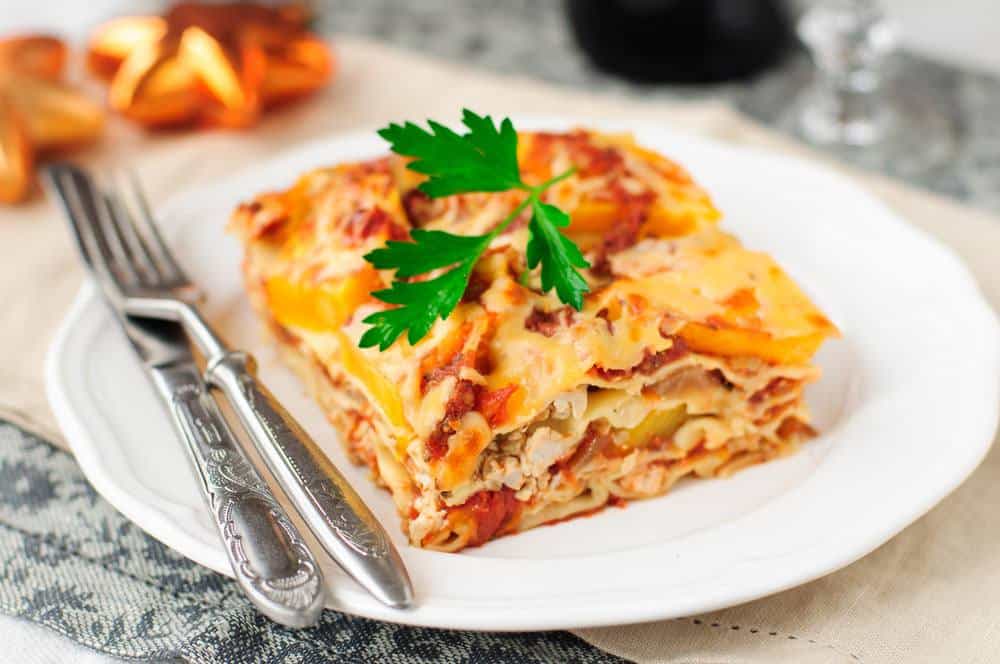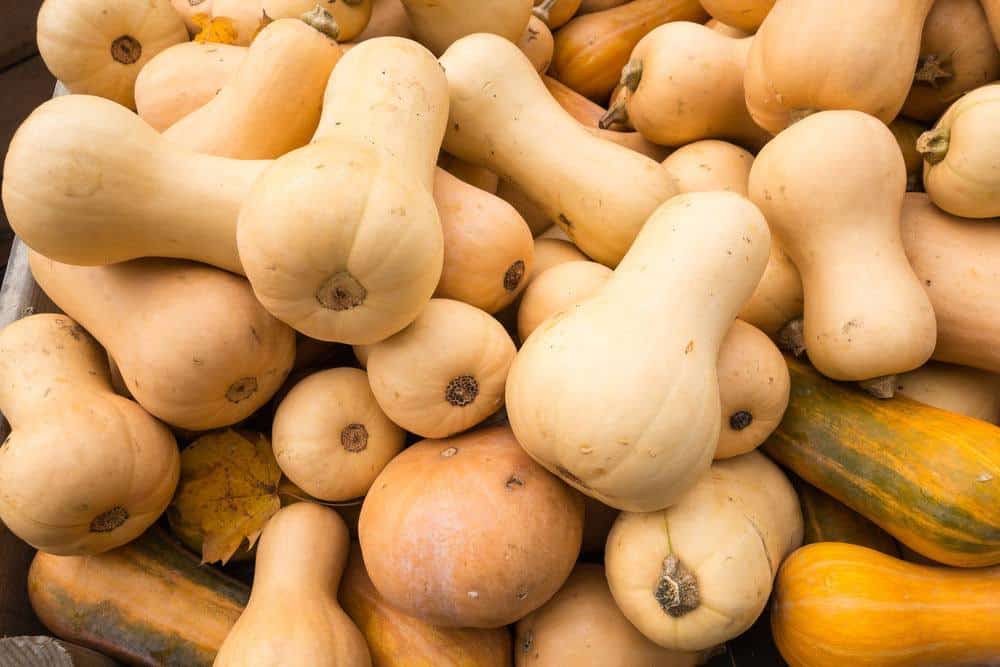Are you craving for a good lasagna, but cannot figure out how to make it vegan and delicious at the same time? We have a great alternative to the cruel and calorie-packed meat and cheese lasagna – a 100% healthy vegan butternut squash lasagna.
Winter is the season of squashes and a great time to try and make something delicious out of them – we have chosen the vegan butternut squash lasagna, made it and loved it – we are sure you will love it as well!
Table of Contents
Why Is Eating A Butternut Squash Good For You?
Although it is called a winter squash, Butternut squash is actually grown during the summer and harvested in the fall, or, to be more precise in the late October and early November.
However, the thick skin allows for it to be stored for several months which makes it suitable to eat during the whole winter season and thus the name winter squash.
It is one of the most loved winter squashes due to the succulent and vibrant flesh which is far tastier and denser than that of its relatives. The flesh is the color of tangerine due to the abundance of carotenoids such as beta-carotene, lutein, alpha-carotene, and zeaxanthin, but most importantly it is sweet and creamy and easy to prepare.
There is a number of ways to eat the butternut squash- you can simply steam it or make a puree that you will use for soup or a dip. It can also be eaten raw in various mouthwatering salads.
However, the butternut squash offers far more than good taste as it is one of the healthiest food you can eat. It is actually considered to be a power food due to its numerous health benefits and an exceptionally high phytonutrient content.
Health Benefits Of A Butternut Squash
Eating butternut squash brings about a reduced risk of many adverse health conditions. Butternut squash is great for maintaining a healthy weight, but also good-looking skin and hair. Furthermore, butternut squash will increase your energy levels and strengthen your immune system.
Butternut squash will also help in the prevention of some serious health conditions such as diabetes, high-blood pressure and heart diseases that count for a great portion of untimely deaths. We have tried to comprise an easy to follow a list of all the health benefits that will inspire you to visit your grocery store and buy a butternut squash immediately:
Prevention Of High Blood Pressure And Maintaining Its Normal Level
Butternut squash is rich in potassium, which is famous for its positive effect on blood. pressure. Besides keeping the sodium intake low, taking enough potassium is the key to maintaining the optimal blood pressure level.
However, the National Health and Nutrition Examination Survey (NHANES) discovered that the majority of adults in the USA have too high levels of sodium in their diet and too low levels of potassium.
Only two percent of Americans reach the daily recommended dose of potassium.
Potassium also helps in keeping you safe from all kinds of stroke that often result in death.
Preventing Asthma
As butternut squash is rich in antioxidant beta-carotene which lowers the risk of asthma. You can recognize the food that has high levels of Beta-carotene by their bright orange color; the other plant foods rich in this carotenoid are sweet potato, papaya, apricots, carrots, and pumpkin.
Lowering Cancer Risk
Carotenoids are well-known antioxidants which are renowned for successfully fighting the free radicals and reducing the damage they make. Most importantly antioxidants reduce the risk from cancer.
For now, studies have definitely proved that consuming a fair amount of carotenoids including the beta-carotene, have a significantly lower risk of developing the colon cancer.
Preventing Diabetes
Pectins, which are the special kind of polysaccharides, and are normally present in the cell walls of the butternut squash regulate insulin levels and are thus great in the prevention of diabetes.
Besides these insulin-regulating and anti-diabetic properties, they also have a significant antioxidative and anti-inflammatory function.
Eating butternut squash can help those people who suffer from type 1 diabetes. These people have to rely on high-fiber diets which help reduce blood sugar levels, and butternut squash is an excellent choice for such a diet.
For those who have type 2 diabetes, the extra fiber is also helpful as it keeps the lipids, blood sugar, and insulin levels in check.
Healthy Skin And Hair
The abundance of vitamin A in butternut squash helps keep your hair and skin healthy and radiant.
Vitamin A regulates sebum production, and thus the hair receives enough moisture. This vitamin also plays a crucial role in the growth of all bodily tissues- this makes it an essential nutrient for all those who hope to keep their skin healthy and good looking too.
Moreover, besides the vitamin A, butternut squash is also rich in vitamin C and can provide almost half of the recommended daily intake of it in only one serving. Vitamin C is another nutrient necessary for the good structure of your skin and hair as it helps build and maintain collagen.
Digestive Health And Obesity
A high fiber diet not only prevents diabetes but also enhances your digestive system.
If you have problems with constipation, butternut squash is an excellent choice for your diet. The dietary fibers will also help
in the prevention of inflammation-related conditions and improve your overall immunity.
Fibers also help fight obesity as they speed up your metabolism and help you feel satiated longer. An optimal fiber intake is crucial for normal cholesterol levels.
Boosting Immune Function
As we have already mentioned, butternut squash is rich in numerous vitamins and carotenoids and thus very beneficial for your overall health and immunity. Eating a lot of butternut squash will definitely help boost your immunity.
How To Choose The Best Butternut Squash?
Butternut squash is available at most grocery stores and farmer’s markets, but it is good to know how to choose a good one that will offer the most of important nutrients. First of all, observe the skin- it should be clear and matte rather than glossy and blemished. If the skin is shiny, the squash has been harvested too soon and will not be as sweet as it should be. Next, take the butternut squash in your hands as to check whether it feels heavy enough.
If you can find organic butternut squash, you should definitely buy it. Namely, according to scientific research, all the winter squashes act like purifiers for contaminated soil. The squash actually acts like a sponge and soaks up with pesticides such as PAHs. This means that even when not sprayed the butternut squashes can get contaminated from the soil they are grown from.
Purchasing a certified organic squash will guarantee that there are no undesired levels of these harmful substances.
Extra Tip: If you need to store the butternut squash for the winter you need to place it into a cool, well-ventilated and dry place. Do not keep it refrigerated! It is best to keep the butternut squash whole as this way you can safely store it for three months, but if you have to cut it, wrap it and keep it in the refrigerator for up to a week.
How To Make Vegan Butternut Squash Lasagna
Finally, we have reached the part you have all been waiting for- our recipe for the marvelous vegan butternut squash lasagna. This lasagna is a great alternative to this traditional Italian dish made with meat and has a lot less cholesterol and fat while keeping the great taste and similar texture.
There are three essential steps you need to follow in order to make the vegan butternut squash lasagna. First, you need to make the butternut squash puree, then the creamy tofu ricotta cheese filling and finally the actual lasagna.
1. Making The Butternut Squash Puree
This is the first step you need to complete when making the butternut squash lasagna Making the roasted squash puree is quite simple.
You Will Need
● Two butternut squashes
● Olive oil
● Salt
● Pepper
● Baking pan
● Baking sheet
● Blender/ potato masher
The Procedure
Preheat your oven to 425 degrees Fahrenheit. In the meantime, use a vegetable peeler to peel the butternut squashes, take out the pulp and seeds from the inside, and finely chop them into chunks (approx. one inch each). Line the baking pan with a sheet of baking paper and spread the chunks onto it.
Generously sprinkle the chucks with olive oil and season with salt and pepper to your liking. Roast them for about half an hour or until they become tender. Use the blender to puree the baked butternut squash (if you do not have a blender you can use the potato masher, but the texture will not be as creamy).
2. Making The Creamy Tofu Ricotta Filling
In order to make vegan butternut squash lasagna, you need a dairy-free filling. We suggest that you make a tofu ricotta.
You Will Need
● 1 lb. of silken tofu
● 2 tablespoons of lemon juice
● One clove of minced garlic
● Salt
● White pepper
● A pinch of nutmeg
● A food processor/ Blender
● Optionally: fresh sage, pine nuts, cashews or almonds
The Procedure
Combine all the ingredients in a food processor or a blender. If you want to stress the sweet taste of the filling you can blend half a cup of almonds, cashews or pine nuts. Alternatively, you can add a pinch of well-minced sage- it will give it a great aroma.
3. Making The Butternut Squash Lasagna: The Final Step
Now that you have the butternut squash puree and ricotta tofu cream filling ready, it will be quite easy to make the lasagna. If you like, you can save the lasagna and bake them later-that will not alter their taste. They are best when eaten warm though.
You Will Need
● Butternut squash puree
● Lasagna noodles
● Ricotta tofu filling
● 8×8 inch Baking Pan
● Aluminum foil
The Procedure
Grease the baking pan, spread one layer of lasagna noodles and cover with the butternut squash puree. Add another layer of lasagna noodles and spread the ricotta tofu cream over it. Continue layering in the same way and make sure to finish off with a layer of ricotta tofu cream.
Preheat the oven to 375 degrees F, cover the pan with aluminum foil and bake the butternut squash lasagna for half an hour. After you take the lasagna out of the oven, let it rest for about fifteen minutes before cutting and serving.
Serving Suggestions:
We recommend garnishing your butternut with fresh sage leaves. You can make a crisp green salad as a side dish. A glass of Chardonnay will make the enjoyment more complete!














